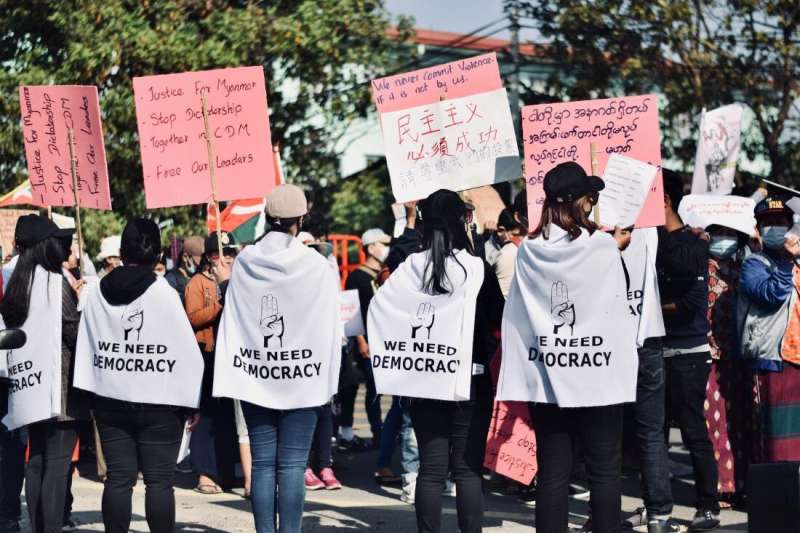Women are crucial to Myanmar’s peace in advocating for women’s protection and inter-ethnic cooperation in the country. Credit: Pyae Sone Htun on Unsplash
Myanmar's formal peace efforts have traditionally involved only men. It's time for that to change.
It may not be obvious to observers but women are playing a quiet, but important role in attempts to bring Myanmar's long-warring parties to some form of peace.
Members of the Women's League of Burma, invited as observers to the formal peace process between 2011 and 2015, informally engaged with the predominantly male negotiators through "hallway meetings," bringing male counterparts tea and food as a vehicle to engage.
Myanmar has been bedeviled by internal conflict since its independence in 1948. Peace negotiations over the decades have been led by men and the elite classes. It has begged many parties to ask: "Where are the women?"
Stopping the conflict between Myanmar's ethnic armed resistance groups and the military dictatorship, which overthrew a military-approved civilian government two years ago, has been overshadowed by the urgent humanitarian, political and economic catastrophe brought on by the coup.
While the prospect of a formal, or "Track One," peace process involving diplomats at the government level is slim, civil society groups, specifically those led by women, continue to play central roles in sustaining peace in both formal and informal avenues developed during the Nationwide Ceasefire Agreement process between 2011–2015.
Bringing sharper focus to this push for more meaningful participation is essential in supporting women's involvement at formal talks and making visible the ongoing key roles women play in multi-track diplomacy which consists of three levels, albeit in parallel, informal and underground formats.
There are three levels to multi-track diplomacy. Women have been absent from Track One, which is the formal process. Track Two is understood as the "in-between" which engages influential parties in discreet and largely off-record talks and is often facilitated by third parties. Many of these activities take place at the civil society organization or community-based organization level, or what would be termed the Track Three level, or the community level.
The question of "Where are the women?" therefore could best be applied to the Track One level, to better challenge the misconception that women have not played a role within the wider Nationwide Ceasefire Agreement peace process.
Women's organizations have been influential in both advocating for women's inclusion and amplified voices within the process and in advocating for women's protection and inter-ethnic cooperation in Myanmar. During the peace process, women's civil society organizations have been active through coalitions that have served as the primary platform for several women's groups in Myanmar across ethnic nationalities to meet and put forth demands. In 2016, it put forward a demand for a gender quota of a minimum of 30 percent representation of women in Myanmar's peace process, but this quota was never met.
In a post-coup environment, understanding that sustaining peace occurs across multiple tracks and outside the confines of a formal Track One peace process is essential. For instance, disparate movements have also been influential in supporting Myanmar women's movements and visibility. In Southern Thailand, movements like the Peace Agenda of Women have brought together 23 women's groups to advocate for women's protection and public safety in Myanmar and near the border.
Movements like #SisterstoSisters are working via social media to raise awareness of violence used on women by the Myanmar military. Sisters to Sisters is largely an advocacy platform that does not seem to engage in dialogue, but instead amplifies women's voices and plights more broadly in the conflict.
Myanmar is incredibly diverse. In the case of women's civil society engagements, the cause of women's inclusion and protection against gendered violence has often helped to build a bridge between ethnic minorities, with women from varied ethnic backgrounds finding a common cause. This is not always as utopian as it may seem, with many ethnic minority women in Myanmar still feeling excluded from advocacy groups.
The influence women as caretakers and community leaders have also played in preventing violence cannot be underestimated. Emerging research has demonstrated how women in Kayah state in eastern Myanmar have often been the sole caretakers of their homes and communities as men leave to find work in other states. Many of these women report feeding troops and working to maintain stability within their community to minimize violence and hostility.
Measuring the exact impact these movements have had on formal decision-making is a difficult and perennial question but as peace processes in Afghanistan, Syria and Ukraine show, there is a need to expand peacemaking strategies beyond the Track One peace table to include more diverse ways of sustaining peace and security for communities in conflict.
Provided by International Development Research Centre (IDRC)
























